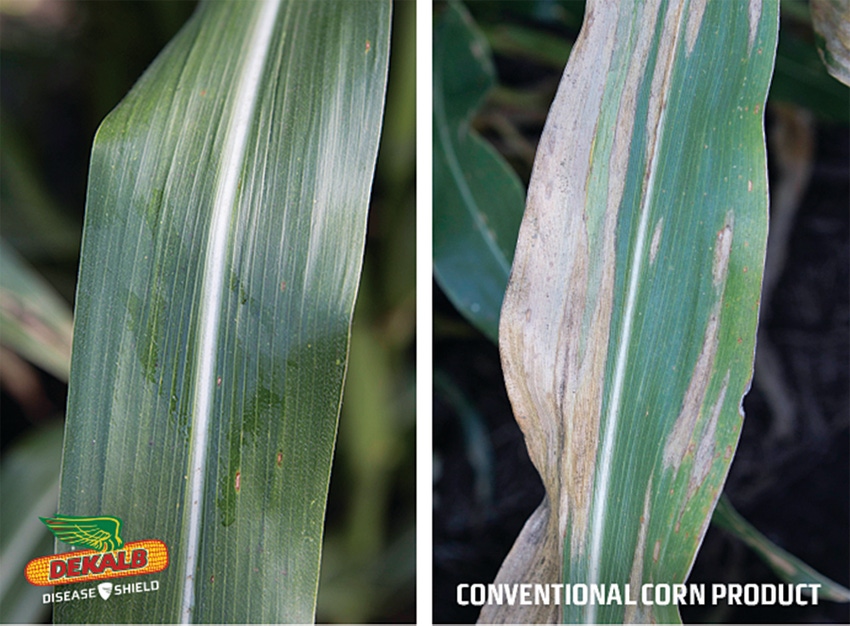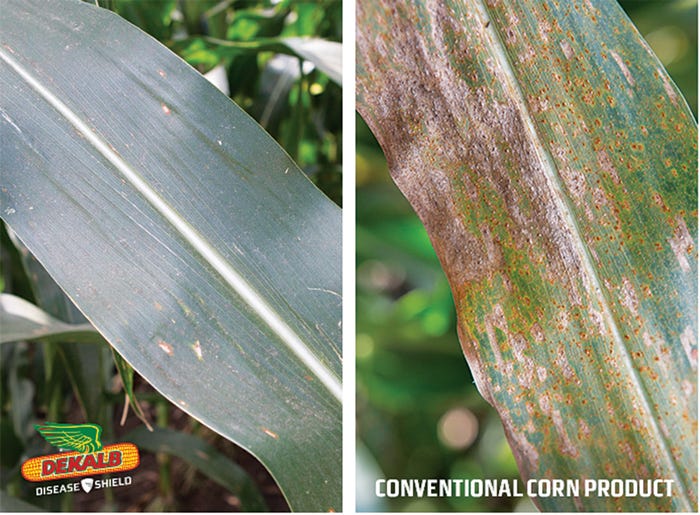
With profit margins for corn growing tighter with each USDA Crop Production Report, a producer’s approach to controlling foliar disease is often a balancing act between protecting yield and keeping down costs.
Several diseases can have a negative impact on corn yields, depending on the level of resistance in a product and weather conditions for the pathogen. Properly identifying diseases and knowing when and which fungicide to apply can increase yield potential. In 2017, growers will also have a breeding innovation to help in their fight against corn diseases.
Northern corn leaf blight (NCLB), a primary foliar disease in the Mid-South, is a good example.
“Fungicide applications are effective on the pathogen,” says Trey Price, plant pathologist at the LSU AgCenter-Macon Ridge Research Station at Winnsboro, “but in most cases, fungicide applications are not necessary for NCLB management. This is an area where producers can reduce input costs.
“We scout, and depending on the stage of the crop and prevailing environmental conditions, we make a decision on a weekly, field-by-field basis, as to whether or not to treat. I think that’s the way to approach it, using integrated pest management techniques instead of blanket spraying fungicides.
“Most of the time, NCLB doesn’t become severe enough to impact yields. In some products, it will become severe under the right conditions. Those products should be monitored more closely.”
There are a number of corn products that are tolerant to NCLB in the Mid-South. Producers can also use crop rotation and tillage practices to hasten decomposition of corn residue. Fungicides may provide an economic return when NCLB is found at late vegetative or early reproductive stages on susceptible products.
Other Corn Diseases

Southern rust
Southern rust management depends largely on the stage of corn growth at the time the disease appears, Price says. “I don’t recommend spraying dent-stage corn for southern rust. There’s no economic return in most cases. However, if the disease appears at or near tasseling, a fungicide application is warranted for management.”Southern rust’s greatest impact on yield occurs from tasseling to milk stage of growth, says Travis Faske, Extension plant pathologist with the University of Arkansas System Division of Agriculture. “Typically, southern rust is detected during the first weeks of July in Arkansas, so growers who plant on time may avoid the greatest impact from this disease.”
Arkansas producers planting corn after May 1 should budget in a fungicide for southern rust, Faske says. “If you do use a fungicide, strobilurins and triazoles have good activity on the disease.”
To aid in treatment decisions for southern rust in west Tennessee, “We look at where we’ve seen southern rust to the south of us, and what weather patterns are forecast,” says Heather Kelly, assistant professor of plant pathology with the University of Tennessee Institute of Agriculture. “If you spray, go out at tasseling stage, but the preferred treatment is to plant products with some resistance or tolerance to southern rust.”
Common rust was more prevalent than southern rust in west Tennessee in 2016, due to a cool, wet spring, Kelly says. “I don’t think it impacted yields. We rarely, if ever, recommend a fungicide application for common rust, but it’s important to distinguish between common rust and southern rust.”
Common rust prefers cool, humid conditions, while southern rust thrives in hot, humid environments. Color differences are also pronounced. Think University of Tennessee orange for southern rust and University of Arkansas red for common rust, says Dr. Faske, referring to the pustules produced by disease pathogens.

Gray leaf spot
Gray leaf spot is one of the most common foliar diseases of corn, and is most severe where minimum tillage is a common production practice, along with warm, humid conditions and continuous corn under irrigation.In fields with a history of gray leaf spot, conventional tillage practices that promote crop decomposition are recommended, along with crop rotation. Foliar fungicides may be economically beneficial on susceptible products to protect high yield potential when conditions favor disease development.
Southern corn leaf blight overwinters in crop debris. Resistant products are the most practical and effective management tactic. Fungicides are rarely economical, except in seed corn production.
In 2017, DeKalb Disease Shield corn products will offer growers a broader spectrum, higher level of tolerance to foliar diseases.
Developed through the brand’s advanced breeding program, DeKalb Disease Shield corn provides enhanced protection against several of the most common corn diseases, including anthracnose stalk rot, gray leaf spot, Goss’s wilt, northern corn leaf blight, and in limited geographies, southern rust.
These products span the 109 to 120 relative maturities for 2017, and will continue to expand in the coming years. “They not only offer great, season-long disease tolerance, but also strong agronomics and elite genetics to help deliver consistent yield performance,” says Jared Webb, brand product manager.
DeKalb Disease Shield products available for Delta farmers in 2017 include:
◆ DKC64-35 brand — a 114 RM VT Double PRO product
◆ DKC66-75 brand — a 116 RM VT Double PRO product
◆ DKC70-27 brand — a 120 RM VT Double PRO product
Webb says DeKalb Disease Shield showed very effective disease protection in on-farm and university trial plots during 2016 in areas that experienced significant disease pressure. “Overall, DeKalb Disease Shield plants were healthier and had excellent stay-green characteristics compared to competitor products, which had less green tissue due to disease lesions on the plants.
“Farmers we’ve heard from are looking forward to planting this product lineup because it helps reduce their risk. From season to season, they never know when a major
About the Author(s)
You May Also Like






